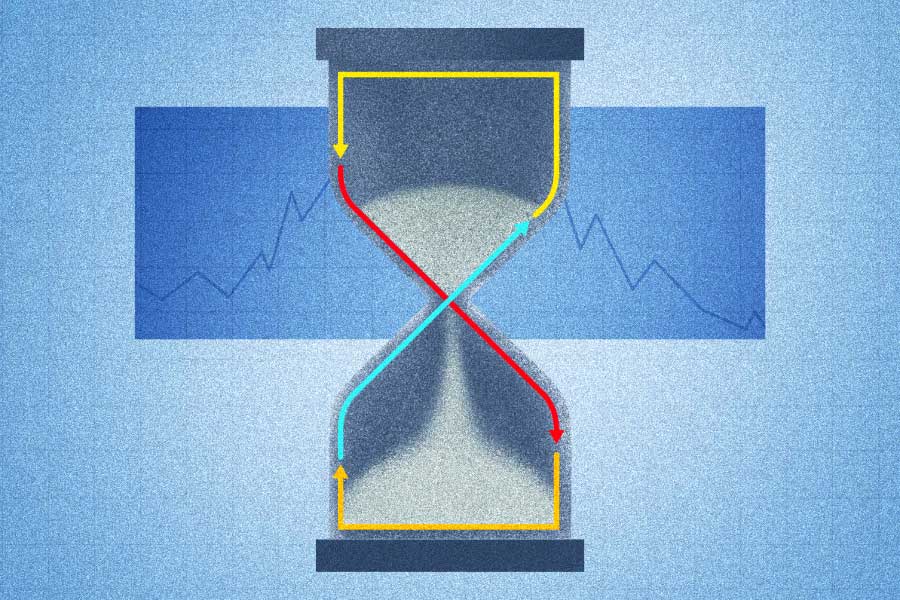The Four Stages of the Stock Market Cycle

From the changing seasons to the phases of the moon, cycles are all around us. Each is driven by unique forces and is often made up of distinct individual stages. Cycles and stages are also present in the movement of stocks, and understanding these patterns can help provide investors with potential insights and investment opportunities.
The four stages of the stock market cycle include accumulation, markup, distribution, and markdown. Let's talk about the features of each and what drives them.
Stage 1: Accumulation
This is the first stage of the market cycle and can be found with individual stocks, sectors, or the market as a whole. It's characterized by meandering, sideways price action that stays within a range and can last a long time, sometimes even for years.
This is the stage when institutional investors begin to accumulate shares. These major players want to acquire large positions but can't do it all at once for fear of driving prices higher and raising their cost basis. So, they buy at regular intervals when the stock hits their desired price levels. This supports the stock and moves it up slightly. Then they wait for the move to be digested and for the price to come back to their target level before repeating the process.
During this stage, few retail investors might participate because price action is unremarkable and doesn't necessarily attract attention. On the other hand, this is where long-term investors might be able to position themselves to scale in or out of positions to take advantage of price movements.
Buying everything at once means investors might miss out on a better price the next day or the next week. A "bite-sized" approach can sometimes be a better choice than buying everything at once. However, this approach can raise your transaction costs, so take that into account.
Stage 2: Markup
Just as the accumulation stage is characterized by support and resistance levels containing the price action of a stock, the markup stage is identified by the share price rallying above the resistance level. When this "breakout" happens, investors often see a spike in volume. This volume spike is caused by an influx of new institutions and individuals who didn't buy during the accumulation stage and are now purchasing the stock.
In the markup stage, price action can go from neutral to trending. If investors begin to see higher highs and higher lows after a price breakout, it can potentially be an indicator that the markup stage has begun. This type of movement can attract investor attention and, as more and more buyers purchase the stock, the uptrend typically gets stronger, eventually becoming parabolic—characterized by a rapid, accelerating increase in price—before entering the next stage.
Throughout the markup stage, investors can use technical analysis indicators like simple moving averages to track key support and resistance levels to better help them keep track of price movements. A simple moving average (SMA) is a technical indicator that's calculated by adding the closing price of a stock or other security over a specific period of time and dividing the total by the appropriate number of trading days. For example, a 20-day SMA is the average closing price over the previous 20 days. (Many trading platforms will do the math and charting for you.)
During this stage—and really at any point in the market cycle—revisiting an original trading plan can help keep investors from straying off course if things don't immediately move their way.
Stage 3: Distribution
This is the topping stage for a stock, sector, or the market in general. The distribution stage signals that a rotation is taking place as early buyers—those who bought during the accumulation stage—as well as later buyers may begin exiting the stock.
One hallmark of this stage is an increase in volume but without an increase in price. This stage often sees the stock's highest volume because bullish sentiment is extremely high but institutional investors are heading for the exits. Initially, new buyers may be able to absorb the selling, but not enough to keep driving the stock higher. In this scenario, the stock can end up collapsing under its own weight.
One way to identify this market cycle stage is through chart patterns, such as a head and shoulders top or double top. A break below the 200-day moving average can also be a confirming signal that the distribution phase has ended.
Stage 4: Markdown (or decline)
This is the final stage of the market cycle, and the one that many investors want to avoid. At this point, buyers who got in during the distribution phase and are underwater on their positions may start to sell. Because institutional players are long gone, there are very few new buyers to absorb the increased selling, which can spur even more selling.
This cascading effect can send prices down very rapidly and in large volume. This phase usually ends when a critical support level is breached and volume spikes many times the daily average, at which point most net selling is exhausted and the stock can return to the accumulation stage once again.
Bottom line
At a more practical level, studying the past chart action of various stocks on a weekly time frame is a great way for investors to learn how to identify all four stages of a stock market cycle. That way you can see how this pattern plays out in the real world and not just in theory.
Understanding the stock market cycle and what drives the individual stages can provide you with insight into a stock's movement. It provides clues about what could happen next based on a well-established pattern. But note that stocks are affected by a wide variety of factors—from product announcements to geopolitical news—and their movements can be unpredictable.